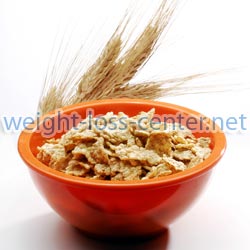As a kid, most of us cringed when mom plopped whole grain toast on the table next to the cereal bowl. Back then, it was difficult to understand why such heavy and strong-tasting bread was better for us than the fluffy white kind. Now that we’re older (and likely shoving whole wheat at our own kids), it’s time we did our homework.

Adding whole grains to your diet has many benefits including improving digestion, fighting hunger, stabilizing blood sugar and lowering cholesterol.
White bread is mostly made of sugar and starches, which happens to make this bread softer and easier on the palate. But alas, white bread really doesn’t offer a significant contribution to one’s health when compared to the bountiful vitamins and minerals that whole grain proffers. Whole grain provides tons of fiber and important nutrients such as folic acid and other B vitamins, iron, magnesium, and vitamin E. Whole grains are also chock full of antioxidants, which are important for gaining control against the body’s free radical cells.
The vitamins and minerals found in whole grains are helpful for lowering cholesterol and blood pressure, which in conjunction also lowers one’s risk of heart disease. Whole grain foods can also benefit diabetics by stabilizing blood sugar levels and enabling safe weight loss. Speaking of weight loss, you’re probably wondering how things like whole grain bread, brown rice, and oats can help you lose weight. The secret? Fiber!
Fiber is a substance that the body can’t really digest, yet it provides loads of health benefits. The most noticeable benefit is that fiber keeps bowel movements regular. Because fiber simply passes through the colon, offering neither nutrients nor calories, it enables toxins and other particles to bond to it, thus removing these “nasties” from the body quickly and efficiently. One of the added bonuses of this is that some of the dietary fats you eat are also pushed out of the body more quickly, giving the body much less time to absorb it.
Foods that are high in fiber also take longer to digest and keep you feeling fuller for longer. This is why many healthy diets intended for weight loss encourage people to eat high fiber foods, such as whole grains, vegetables and fruits at meals and for snacks instead of filling up on processed foods that are quickly digested and leave you feeling hungry in no time (for more information about the benefits of fiber, read the post “How Fiber Helps Weight Loss”).
If you already get your fill of common types of whole grains, such as whole wheat products, brown rice and oats, why not consider trying some of these other whole grains to add variety to your diet?
Quinoa – Quinoa is not technically a whole grain, however it provides the same health benefits of whole grain and is very easy to cook with. This seed-like grain can be prepared as a savory dish, similar to rice, or as a sweet dish served with honey and berries. Quinoa can also be a tasty addition to homemade granola and can be served with vegetables in a Quinoa salad. This is an easy grain to experiment with so have some fun.
Bulgar – Bulgar is a whole grain that is similar to cracked wheat, only bulgar is pre-cooked (which makes preparation a cinch). This grain is described as having a mild flavor with undertones of nut. It is available in many different grain sizes which makes it very versatile to cook with. Finely-ground bulgar can be made into a hot cereal while larger grains can be added to soups, bread, and salad. Bulgar can also be used instead of rice in many dishes. One of our families favorite is Spanish Bulgar (Spanish rice, but made with bulgar instead).
Millet – You could also try millet, which is a small seed produced by a grass-like crop. Millet can be quite bland on its own, as most grains can be, but it takes very well to seasoning. It makes an excellent replacement for rice and can be used in stuffing, cereal, and baked goods.
Kasha – Kasha is another worthy grain to try. Although in most parts of the world this porridge is made of up crushed grains, some areas derive kasha from buckwheat. Some forms of kasha are roasted, giving this food a distinct nutty flavor that is very pleasant! Although kasha can take a while to cook, it’s very versatile and can be made into a warm breakfast food or used as filler in pasta or other warm meals.
Wheat Berries – Last, but not least, we have wheat berries. A wheat berry is simply a whole grain kernel that has had the husk, or outermost portion, removed. Wheat berries are a fun grain because they have a nice chewy texture that doesn’t turn sloppy after cooking. These grains can be added to salad, seasoned with herbs, or mixed with fruit and chilled.
The possibilities of preparing whole grains are endless! If you are looking to give your diet a kick start in the right direction, be it for health or weight loss, then give some of these diverse whole grains a try!
Do you have a recipe you would like to share that includes one of the grains mentioned above? If so, please leave it in our comment section below for others to try.
Other Related Posts and Articles you May Find Interesting: “Foods that Improve Heart Health”, “Why You Need Carbohydrates”, “Designing Your Own Hunger Free Diet” and “Foods that Stabilize Blood Sugar”.





Adding whole grains to your diet is easier then ever in this day and age! There are so many varieties of whole grain breads and buns now available. Some are made from multiple sources of whole grains such as wheat, spelt, barley and oats. Look for food labels that confirm that the product is made with 100% whole grain. Some brands of bread that advertise “whole wheat” on the label are actually a mixture of whole grains and refined white flour. Use whole grain brown rice instead of refined white rice in your recipes. Not only will you be adding important dietary fiber to your diet, you’ll also be helping to stabilize your blood sugar levels. Refined grains break down very quickly into sugar which can cause spikes in blood glucose levels. The subsequent fall of blood sugar often results in food cravings. Use whole grain pasta the next time you make a pasta salad or lasagna. The whole grain varieties have great texture and hold up better than the plain types that tend to get soggy easier. See how easy it is to substitute for whole grain ideas? I find they taste better too!